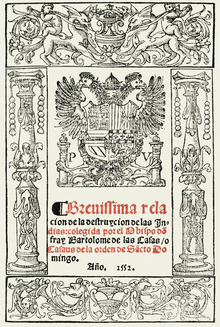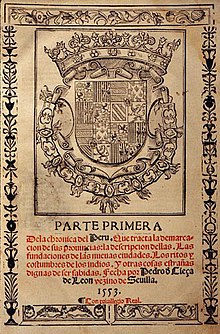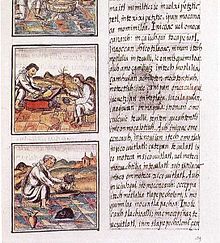Latin American literature
Latin American Literature referred to in the languages of Latin America written literature , mainly in the Romance languages Spanish and Portuguese , and French . Latin American literature has been described as a melting pot of cultures ( crisol de culturas ).
Depending on the definition, in addition to Hispano-American or Ibero-American literature, the literatures in the many languages of the indigenous ethnic groups of South and Central America are included, as well as Afro-Brazilian literature ( Poesia negra etc.) For example, there is also Latin American literature written in Spanish in the United States .
Historical overview
Important moments in Latin American literature are the arrival of the representatives of the colonial powers ( Conquista ), the mission of the Jesuits , which led to independent forms of Baroque literature, and the independence of the countries from colonial rule . The Wars of Liberation were accompanied by the rise of national romanticism. Later, the agrarian character of Latin American societies was reflected in the style of Costumbrismo , which for a long time prevailed in regional variations on the entire subcontinent. Towards the end of the 19th century, national literatures developed that increasingly emancipated themselves from Spanish and Portuguese models. The term "Latin America" and its use instead of the term Ibero America reflects this process, which led to a stronger orientation towards French models of symbolism and naturalism . The relatively low cultural exchange relationships between the Latin American states, which were replaced by those with Europe and later with the USA, also contributed to the emergence of these national literature.
Since the 1930s, Latin American literature has realistically focused on the social problems in the countryside, particularly among the indigenous peoples, and increasingly also in the big cities. Due to sometimes long periods of dictatorship in many countries and the massive exile of intellectuals, there was a stronger exchange between the literatures.
In the second half of the 20th century, Latin American literature grew in popularity, particularly due to the development of the style known as " magical realism " (Spanish realismo mágico ). One speaks of a boom generation. The strong increase in interest in Latin American authors has worldwide authors such as Augusto Roa Bastos from Paraguay , Jorge Luis Borges , Ernesto Sabato and Julio Cortázar from Argentina , Carlos Fuentes from Mexico , Mario Vargas Llosa from Peru , Pablo Neruda from Chile and Gabriel Garcia Marquez from Colombia Brought recognition. Juan Carlos Onetti from Uruguay also found this recognition towards the end of the 20th century .
The next generation of authors after the early boom include authors such as Roberto Bolaño , Isabel Allende , Elena Poniatowska and Luisa Valenzuela . Towards the end of the 20th century, exile, migration and globalization led to new cultural transgressions and thus to the increasing hybridization and transculturality of Latin American literature (s), with US literature, popular culture and indigenous culture making important contributions.
Six Latin American authors have won the Nobel Prize for Literature : the Chilean poet Gabriela Mistral (1945), the Guatemalan novelist Miguel Asturias (1967), the Chilean poet Pablo Neruda (1971), the Colombian writer Gabriel Garcia Marquez (1982), the Mexican poet Octavio Paz (1990) and the Peruvian writer Mario Vargas Llosa (2010).
Various authors have also been awarded the Spanish Premio Cervantes , the Portuguese Prémio Camões and other international literary prizes.
In the UNESCO collection of representative works ( Collection UNESCO d'œuvres représentatives ) there is an Ibero-American series ( Série ibéro-américaine ). Among others, Andrés Bello ( Naissance d'une pensée latino-américaine ), Flor Romero de Nohra ( Crépitant tropique. Roman. Un village colombien à l'heure de la guérilla ), the manuscript Tovar : origines et coyances des indiens du Mexique , a Bolivar selection, Concolorcorvo ( Itinéraire de Buenos-Aires à Lima ), Juan Zorrilla de San Martín ( Tabaré ), Gabriel René Moreno ( Les derniers jours de la colonie dans le Haut-Pérou ), Josué Montello ( Les Tambours noirs : la saga du nègre brésilien ), José Enrique Rodó ( Motifs de Protée ), Horacio Quiroga ( Contes d'amour, de folie et de mort ), Domingo Faustino Sarmiento ( Facundo ), John Lloyd Stephens ( Aventures de voyage en pays maya ) , Alonso de Ercilla y Zúñiga ( La Araucana: le cycle de Lautaro ), Garcilaso de la Vega ( Commentaires royaux sur le Pérou des Incas ), Bernardino de Sahagún ( Tenochtitlan México , ed. Jacques Donvez), Joaquim Maria Machado de Assis ( Quincas Borba ) u. a.
Overview
Indigenous languages of Latin America : see the beginnings of Latin American literature
Portuguese : Brazilian Literature
Spanish : Argentine literature - Bolivian literature - Chilean literature - Colombian literature - Costa Rican literature - Cuban literature - Dominican literature see Caribbean literature - Ecuadorian literature - Guatemalan literature - Honduran literature ( writers ) - Mexican literature - Nicaraguan literature - Panamanian literature see Panama - Paraguayan Literature - Peruvian Literature - Puerto Rican Literature see Caribbean Literature - Salvadoran Literature - Uruguayan Literature - Venezuelan Literature
French etc .: Literature of French Guiana - Literature of Guadeloupe - Haitian Literature - Literature of Martinique - see Caribbean Literature
See also
- Category: Latin American Literature (by Country)
- Travaux et mémoires of the Institut des hautes études de l'Amérique latine (IHEAL)
References and footnotes
- ↑ See also French-Caribbean literature , influenced by Haitian Creole , etc.
- ↑ Rubén Bareiro Saguier: La Literatura latinoamericana: crisol de culturas (unesdoc.unesco.org), p. 27
- ↑ See e.g. B. the selection bibliography (unesdoc.unesco.org)
- ↑ See e.g. B. Thorsten Thiel: There is More than One Site of Resistance: Irony and Parody in the contemporary novel of the Chicanos / as. Heidelberg: Winter, 2003 ( American Studies , Volume 98)
- ↑ cf. Martin, Gerald (1984), "Boom, Yes; 'New' Novel, No: Further Reflections on the Optical Illusions of the 1960s in Latin America", Bulletin of Latin American Research (Blackwell Publishing). - Т. 3 (2): 53-63
- ↑ Eva Gugenheim, Kathrin Sartingen; Hybridity - transculturality - creolization: innovation and change in the culture, language and literature of Latin America. (= Atención! Yearbook of the Austrian Latin America Institute, Vol. 14) LIT Verlag Münster 2011.
- ^ All Nobel Prizes in Literature
- ↑ cf. Klaus-Dieter Ertler: Small history of the Latin American novel . 2002, p. 59 ff.
literature
- Karl Kohut: Brief Introduction to Theory and History of Latin American Literature. 2016 partial online view
- Hans-Otto Dill: History of Latin American Literature at a Glance . Stuttgart: Reclam, 1999. (Universal Library; 9738) Review
- Michael Rössner : Latin American literary history . 3rd, exp. Metzler, Stuttgart 2007, ISBN 3-476-02224-2
- Roger Bastide : Les Amériques noires: les civilizations africaines dans le Nouveau Monde. 1967 ( review by Michel Leiris )
- David William Foster: Handbook of Latin American Literature . Garland Pub., 1987
- Christoph Strosetzki: Introduction to Spanish and Latin American literary studies . Erich Schmidt Verlag, Berlin 2003, ISBN 3-503-06189-4
- The Cambridge History of Latin American Literature (1996), 3 volumes, edited by Roberto Gonzalez Echevarría, Enrique Pupo-Walker
- Rudolf Grossmann: History and Problems of Latin American Literature . Max Hueber Verlag, 1969
- Dieter Günther: Latin American literature from its beginnings until today . RG Fischer, Frankfurt am Main, 1995, ISBN 3-89501-192-4
- Major works of Latin American literature. Individual presentations and interpretations . ISBN 978-3-463-40280-2
- Christoph Strosetzki: A short history of Latin American literature in the 20th century . Münich, 1994 / ISBN 3-406-37438-7
- Wolfgang Rössig (Hrsg.): Major works of Latin American literature: individual representations and interpretations . Munich, Kindler, 1995, ISBN 3-463-40280-7
- Wolfgang Eitel (Ed.): Latin American literature of the present in single representations (= Kröner's pocket edition . Volume 462). Kröner, Stuttgart 1978, ISBN 3-520-46201-X .
- Strausfeld, Mechtild (ed.): Latin American literature . Suhrkamp Verlag, Frankfurt a. M., 1983
- Strausfeld, Mechtild (Ed.): Materials on Latin American literature. Frankfurt am Main: Suhrkamp Verlag, 1976 (= Suhrkamp pocket books. Volume st 341). ISBN 3-518-06841-5 ( Jorge Luis Borges , Adolfo Bioy Casares , Alejo Carpentier , Juan Rulfo , Augusto Roa Bastos , Juan Carlos Onetti , Julio Cortázar , Carlos Fuentes , Octavio Paz , Gabriel García Márquez , Mario Vargas Llosa , Manuel Puig , Manuel Scorza )
- David William Foster (Ed.): Handbook of Latin American Literature . Garland Reference Library, 1992
- Dieter Reichardt: Nice literature by Latin American authors - An overview of the German translations with biographical information. ( Bibliography and documentation ) Issue 6, Hamburg 1965 ( Institute for Ibero-American Customer )
- Ralph Ludwig: Introduction à la littérature caribéenne. Franco-Caribbean Literature: Stages and Perspectives . (Presses universitaires créoles)
- Théâtre latino-américain contemporain - Miguel Ángel Asturias ; Carlos José Reyes ; Egon Wolff ; Emilio Carballido ; Enrique Solari Swayne ; Griselda Gambaro ; José Ignacio Cabrujas ; José Triana ; Luis Rafael Sánchez ; Nelson Rodrigues ; Ricardo Prieto . Introduction by Osvaldo Obregón , translated from the Spanish by Albert Bensousan ( UNESCO Collection of Representative Works )
- Rubén Bareiro Saguier (ed.): Anthologie de la nouvelle latino-américaine. 1998 ( UNESCO collection of representative works )
- Federico de Onis (Ed.): Anthologie de la poésie Ibéro-Américaine. Choix, introduction and notes from Federico de Onis. Presentation de Ventura Garcia Calderon. Paris, Editions Nagel, 1956 ( Collection Unesco d'oeuvres représentatives , Série Ibéro-Américaine, N ° 9)
Web links
- The time of magical realism is over (Sarah Murrenhoff)
- Land in sight (Wolfgang Reinhard)
- The slave- owner mentality is only apparently over (interview with Cuti 2012)




